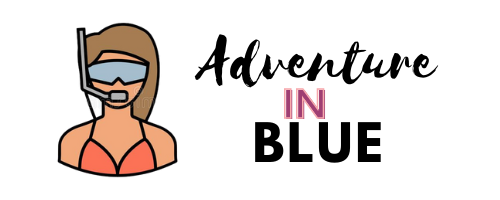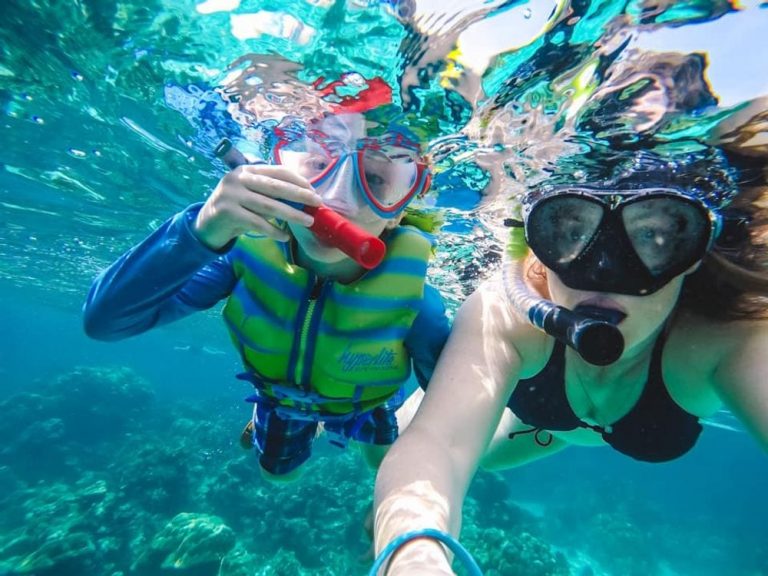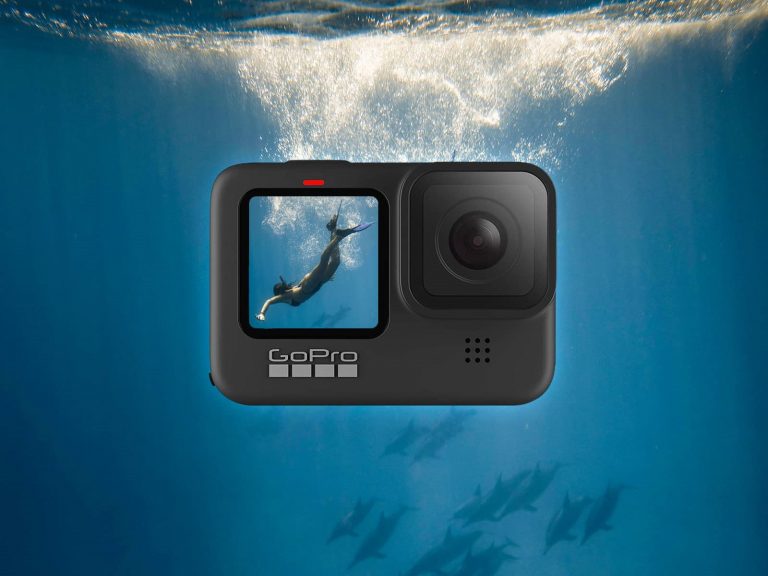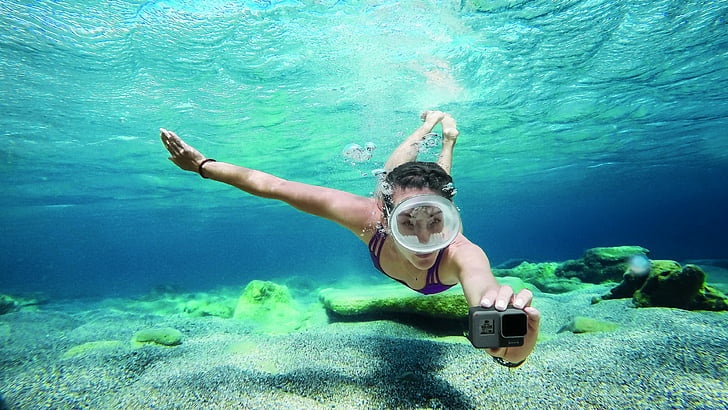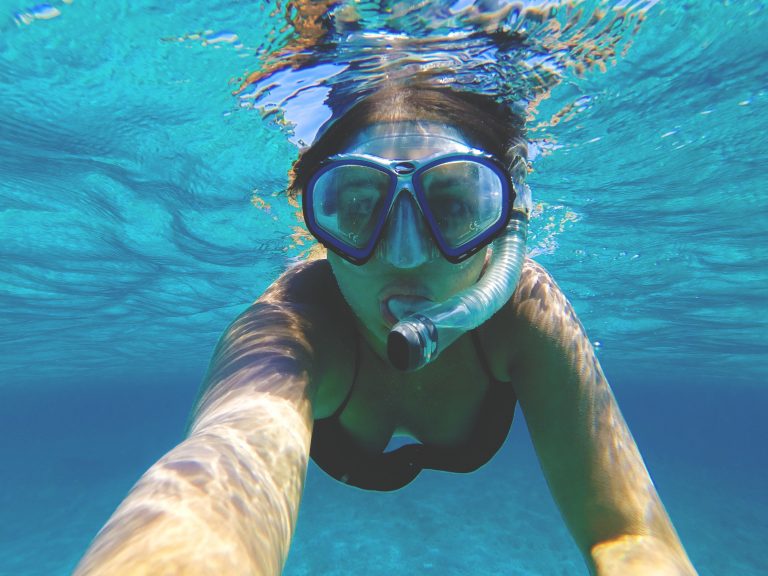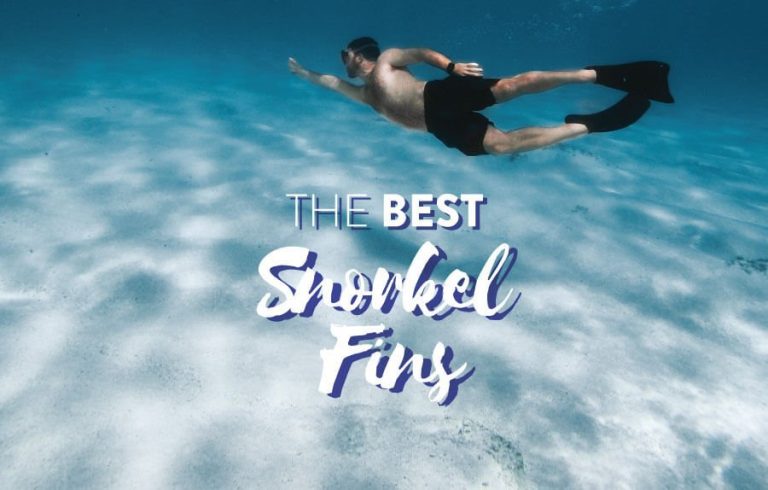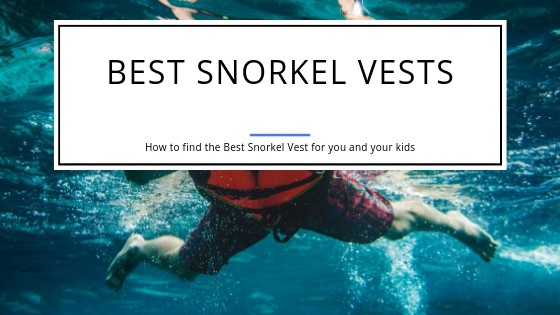What snorkel gear should I buy?
What snorkel equipment should i get? The ultimate guide to begin confidently and inexpensively
What snorkel gear should I buy? The full guide to getting started affordably
Snorkeling is a magnificent chance to capture memorable experiences, float through underwater environments that may often feel like just another universe, and spend time with majestic marine species in their natural home. It’s a fascinating, one-of-a-kind, and straightforward sport.
However, like other activities, snorkeling requires some tools to get started. Luckily, unlike scuba diving, snorkeling needs very little gear and money to begin having those great experiences. That’s fantastic.
However, as with other sports, the equipment offered can vary significantly in function, price, durability, and a variety of other aspects that you may not be aware of unless you’ve been actively fascinated with snorkeling for many years. (like yours genuinely 🙂).
What Snorkel Gear Should I Buy?
“What snorkel gear should I buy?” is generally the first question I hear from experienced and new snorkelers seeking to improve their experiences on the ocean. Generally, the only equipment necessary to start snorkeling is a snorkel mask and snorkel, but there is a variety of extra gear available, such as rash guards, sun protection, flotation devices, and fins, that may make your adventure safer and more enjoyable.
There are so many types of gear available that it can sometimes be overwhelming. That’s why I’ve crafted this comprehensive guide to what snorkel gear you’ll need and the best snorkel gear to get you out on the water inexpensively and confidently.
I divide snorkel gear into 3 groups: snorkel gear that is absolutely necessary, snorkel gear that is highly recommended, and snorkel gear that is simply good to have. As we proceed, I’ll explain what’s in each section and offer you my choices for the best snorkel gear.
Snorkel gear you absolutely need
One of the most appealing aspects of snorkeling is that the only equipment required to enter the water is a mask and a snorkel. Most significantly, you should analyze the materials utilized in their manufacture, features available, seal reliability, and pricing points. But, from there, there are approximately a million and one possibilities, so let’s look at what gear I think is ideal for getting you started snorkeling.
Best Snorkel Masks
The first step will be to get a snorkel mask to protect your eyes (and nose) while snorkeling. And, for something so significant, we don’t want to cut corners, but we also want to ensure that anything we choose will provide us with excellent value for money.
(Check out Complete Article about Best Snorkel Mask)
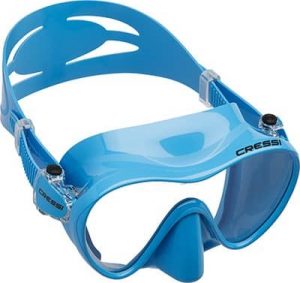
Beginner Snorkel Mask
If you’re just getting started with snorkeling and want to get your feet wet (oops), our favorite best beginner mask is the Cressi F1 (view on Amazon). It has a slightly enhanced tempered-glass lens (a bonus for safety and real vision) and fits an unframed design format, which means there is no solid frame around the border of the mask, which many people prefer for comfort and mask seal quality.
Cressi is also a well-known and renowned snorkel maker, which is essential to mention given the prevalence of questionable knock-off snorkel equipment in the novice category on the internet, which may or may not be safe.
The Cressi F1 (Amazon) provides excellent value for money at around $30. It also comes in various colours, which is always a plus.
Intermediate Snorkel Mask
If you’ve previously had some experience snorkeling (or simply want to dive in with a relatively high snorkel mask), our #1 selection is the SCUBAPRO Solo (view on Amazon).
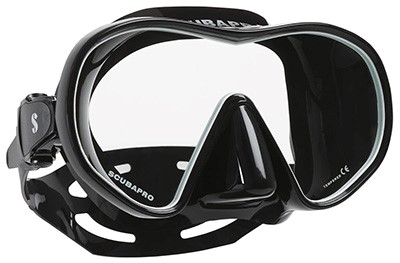
The Solo excels in the intermediate category, thanks to features like its large unified tempered-glass lens (which allows you to see more and better) and a double-silicone skirt, which helps form a more reliable mask seal around your face to keep out undesired water.
My experience with the durability of this mask has been quite excellent, withstanding a lot of unintentional abuse (not that I ended up bashing it about a lot or anything…), and the same goes for my comment on comfort: I’ve had nothing but positive experiences with the Solo. The SCUBAPRO Solo snorkel mask (Amazon) is a bit more expensive at approximately $110, but if you plan on snorkeling more frequently or sometimes a year, the upgrade will benefit you a better all-around experience every single time you’re in the ocean.
Advanced Snorkel Mask
Do you want to get the best snorkel mask that money can buy? Yes, I understand entirely. These innovative masks leave little to be desired regarding appearance, comfort, or performance. Nothing much requires you to be an accomplished snorkeler to utilize one of these masks. They just have the most additional features that professional snorkelers choose.
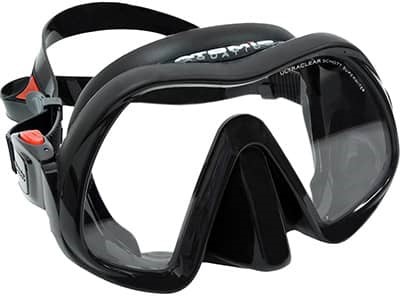
The Atomic Venom Frameless is our best choice for the best snorkel mask on the market (view on Amazon). It is, without a doubt, an excellent snorkel mask, in our opinion.
My favorite aspect of Venom (and many of Atomic’s high-end masks) is the ultra-clear tempered glass lens’s incredibly high-level performance. Even though I was initially doubtful, the tempered glass used in snorkel masks may make a visible impact, especially in waters with less clarity.
Then there’s the comfortable seal mechanism, lightweight design, and almost every other item on the list. Plus, it looks cool, and no one I’ve talked to who has a Venom has said anything negative about the mask. The Atomic Venom Frameless snorkel mask (Amazon) costs over $170, which is on the higher end of the price range for snorkel masks. If you are a frequent snorkeler or want the best, the additional few dollars on this jewel are well worth it.
Prescription Snorkel Masks

Also, for those of us who don’t have the most excellent eagle-eyed vision and require corrective glasses to see correctly, there are a variety of helpful snorkel mask solutions available, ranging from snorkel mask lens plugs to drop-in lenses to attached lenses to fitted lenses and numerous other possibilities.
The techniques for selecting the correct snorkel mask for someone who needs prescription eyeglasses to see can vary significantly in terms of cost (anything from $30 to $300) and effort, and the subject merits its own article to sort out the different benefits and trade-offs of each.
So, if your eyesight isn’t 20/20, read our post on Can You Snorkel With Glasses? 7 Great Ways to See Underwater.
Snorkel Tubes
Next, we need to select a suitable choice for the snorkel itself. Snorkels are divided into several groups, each with a different function and target audience. Make sure you learn about each type below to choose which one is ideal for you.
Dry Snorkels
There was formerly only one sort of snorkel: a classic tube (also known as a wet snorkel) that simply linked your mouth to the air above the water’s surface. However, snorkel technology has advanced significantly since then.

There are dry snorkels, including little one-way valves at the top of the breathing tube that seeks to block any unexpected water from coming in (which may and does happen while snorkeling) while still enabling you to breathe correctly. They are usually quite effective.
Dry snorkels are wonderful for snorkelers of all abilities, but they are especially beneficial for beginners. One of the most challenging aspects of learning to snorkel comfortably is being accustomed to dealing with unwanted water, and dry snorkels eliminate a significant portion of that learning curve, allowing newbies to get started with greater confidence.
If you want to dive deep, the only major disadvantage of dry snorkels is that the trapped air between the mouthpiece and the dry valve provides some buoyant restriction. That means you won’t be able to wear one when scuba diving, but the resistance is barely perceptible for anyone other than the most finely-tuned expert snorkelers, so I don’t think this is a deal-breaker. When shopping for a dry snorkel, search for snorkels from reputable manufacturers with proven safety histories, as the quality of the valve at the top of the snorkel is critical.
The Oceanic Ultra-Dry 2 (see on Amazon) is our top suggestion for the best dry snorkel due to its great dry valve and super-useful purge valve (This allows you to expel any stray water out the bottom of your mouthpiece if it gets into your snorkel).
The Ultra-Dry 2 is also extremely lightweight (you can scarcely feel it most of the time) without introducing any durability difficulties, and the mouthpiece is really soft, which is highly beneficial for prolonged snorkel sessions.
The Oceanic Ultra-Dry 2 will set you back around $60, which is on the pricier end of dry snorkel costs, but you get what you pay for here. If you’re not quite ready to invest $60 on a snorkel, we also recommend the Cressi Supernova Dry (see on Amazon). It’s reasonably priced at around $20 and has many of the same characteristics as the Ultra-Dry 2. And while it may not have the same finely-tuned performance, it’s an excellent choice if you’re a newbie who isn’t yet ready to upgrade.
Semi-Dry Snorkels
Semi-dry snorkels are a relatively new addition to snorkel technology, and they try to bridge the gap between dry and wet snorkels. They have an open breathing tube, just like a wet snorkel, but they aim to mimic the water protection of a dry snorkel by incorporating a splash guard at the head of the breathing tube to keep stray water out. They are not as effective as dry snorkels but far superior to ordinary wet snorkels.

Semi-dry snorkels are often marketed to intermediate-to-advanced snorkelers who desire as much water resistance as possible without compromising performance for more advanced activities such as lengthy underwater diving.
You should search for something with a perfect splash guard to keep out as much water as possible combined with an expertly purge valve to readily evacuate any water which does make it through when you re-open the top of the breathing tube, which occasionally may admit at least some water into the tube with semi-dry snorkels.
The Atomic SV2 is our pick for the best semi-dry snorkel (view on Amazon). It does cost more than the average snorkel (about $70), but at this intermediate-to-advanced level, performance is critical, and I don’t want to risk getting anything less well-designed than the SV2 and having a problem out on the water. Regarding reducing splash intake, the Atomic SV2’s curved shape with its slanted splash guard is well praised, and the purge valve performs well with minimum pushed air. So it clearly meets the need for a high-performance semi-dry snorkel.
Traditional Wet Snorkels
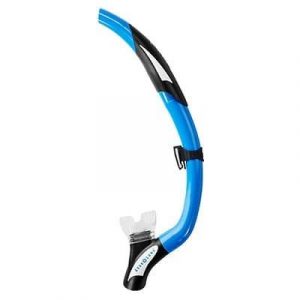
Finally, typical wet snorkels with a fully-open top are still popular among skilled snorkelers, old-school snorkelers who are familiar with this style, and those who prefer something as simple as possible to use when scuba diving.
Wet snorkels have their place; however, with the development of dry snorkels, whether you’re a novice or a more advanced snorkeler, a wet snorkel should be avoided.
The extra safety of a dry snorkel (or, at the very least, a semi-dry snorkel) is simply too appealing.
Still, if you’re a more experienced or old-school snorkeler looking for a fantastic conventional snorkel, we recommend the Aqua Lung Impulse 3 (view on Amazon).
Some snorkel technology has followed this specific wet snorkel with an excellent flexible shape, a super-comfortable mouthpiece, and an effortless purge valve. Luckily, it’s not your grandpa’s wet snorkel.
Full-Face Snorkel Masks
Full-face snorkel masks are a new kid on the block that integrates both your standard snorkel mask and a dry snorkel.
These full-face snorkel masks have a dome that covers your entire face from forehead to chin for increased visibility and an integral dry snorkel at the top of the mask with the same one-way valve that hydrated out while enabling air in.
It’s a fantastic concept. However, in recent years, there have been reports that some persons have had difficulty or injury when using these masks in the water, probably due to the built-in valve not releasing enough expelled CO2 and not letting enough fresh air into the mask on inhale.
However, many individuals swear by these masks, and the only difference is whether or not the mask is created by a high-quality company with a reputable safety reputation. According to anecdotal evidence, some lower-quality or knock-off masks may have inserted poorer valves.
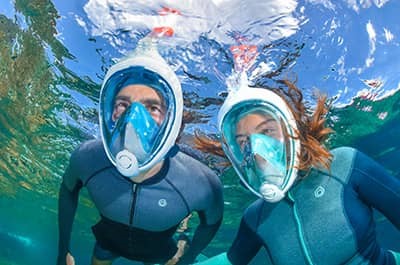
However, the judgment is still on whether these masks can be officially deemed “safe.” The Hawaii Department of Health is investigating it and has indicated that “there is presently enough knowledge to show a causal relationship to higher risk.” However, you need to do further study to discover if this sort of mask is good for you and test it before getting in the water to ensure that the valve enables you to breathe correctly. I’ve worn full-face snorkel masks for casual swims that don’t need diving (the airflow in the mask makes it too buoyant to dive effectively), and my personal experiences have been great. However, you may be different and naturally want to make your own decisions and judgments.
Tribord and Mares/Seaview are two brands that have routinely received good scores for full-face snorkel masks. Their full-face mask products, Tribord’s Subea Easybreath (see on Amazon) and Head by Mares’ Seaview, are incredibly similar (view on Amazon).
They both do an excellent job of encapsulating all of the benefits of a full-face snorkel mask — expanded field of view, dry snorkel technology, superior comfort, and so on — and customer feedback is excellent. If the valve tales bother you, you may still have a fantastic day on the sea with a standard snorkel mask and snorkel. It’s as simple as that.
If you’re looking for a full-face mask, I’ve been using the Tribord Subea Easybreath (see on Amazon) model for several years (you can also check a separate complete article about Best full Face snorkeling Masks). For me, the valve has done an excellent job of keeping water out while still allowing me to breathe normally, and the mask has been an excellent complement for simple snorkel dives when I want to see as much as possible while still having maximum water protection.
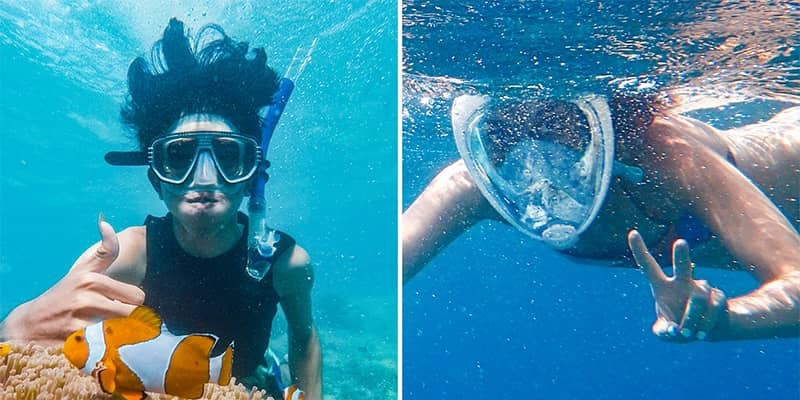
Snorkel gear that is highly recommended
Now that we’ve covered the fundamental necessities (mask and snorkel), let’s take a look at some things that, while you can absolutely snorkel without them, I would strongly recommend looking into because they have a significant influence on safety and having a good time.
Sunscreens
Maintain the health of your skin! It is pretty significant. What’s more, it’s critical to maintain the ocean healthy while you’re at it.
You’ll probably be in the sun while snorkeling (or just getting on the boat, lounging on the beach, etc.) and should apply sunscreen frequently. However, not all sunscreens are made equal when it comes to water.
For starters, you’ll need water-resistant sunscreen. Because you’ll be spending a lot of time in the water, a lotion that washes off quickly won’t do you any good. Another consideration is choosing a “reef-safe” sunscreen; quite so many sunscreens used for land-based activities include ingredients harmful to coral reefs and aquatic life.
Some places, such as Hawaii, have even established legislation prohibiting the sale and use of skin care products containing ingredients such as oxybenzone and octinoxate, which have been linked to reef destruction even when not directly used in the water. Excess sunscreen spray, for example, can sink into the sands and ultimately wash into the ocean, or sunscreen that you wipe off in the showers at the end of the day can also wind up in the sea. [source].

We must preserve our skin while protecting the water we’re snorkeling in if we want to keep snorkeling. Make no compromises in any case.
Alba Botanica’s Sensitive SPF 50 sunscreen is my favorite reef-safe sunscreen (view on Amazon). It’s strongly water-resistant (supposedly to 60 minutes), covers readily, protects effectively with a 50 SPF rating, and is biodegradable. It also outperforms most sunscreens on the Think Dirty app, which assesses goods based on the cleanliness of their components.
Also worthy of consideration is Safe Sea’s Sunscreen & Jellyfish Sting Protective Spray, which serves as both a reef-safe sunscreen and a repellant to jellyfish and sea lice. Most reviews for the product state, “I used it and didn’t get hurt by almost anything,” but it’s impossible to say whether the sunscreen prevented the reviewers from being stung or whether they would not have been harmed even without the spray. Who can say?
Still, I use it when I’m in waters known to contain jellyfish or sea lice (although I avoid water if there are significant quantities of jellyfish or hazardous types because it’s just common sense).
(For additional information on how reef-safe sunscreen works and why it’s vital, read The 2 Best Snorkeling Sunscreens: Reef Safe & Biodegradable.) Also, if you have children on the beach or boat, you’ll need reef-safe sunscreen for kids, and my favorite one is Goddess Garden’s Kids Sunscreen (here on Amazon). It is reef-safe, has a high SPF50 sun protection rating, and is water-resistant for up to 80 minutes. It’s also designed specifically for more delicate skin (such as that found in children), and it doesn’t stink, so putting it on isn’t as tricky.
Rash Guards
I also strongly recommend purchasing a rash guard, a form-fitting, a water-resistant garment that you may wear when snorkeling. It has two main advantages: one, it gives a little more insulation when snorkeling in calmer waters, and two, it provides better sun protection.
I don’t get cold quickly, so I don’t use the first benefit as often as my wife does, but I can remain in the water snorkeling for over an hour at a time. And, when my back, neck, and shoulders look up at the sun for the duration, the more coverage I have on my body, the ideal (and I can use less sunscreen this way).
My boyfriend wears the Volcom Men’s Lido Solid Short Sleeve Rashguard (see on Amazon) because it covers her core while allowing me to move freely. Because it provides more excellent insulation on the arms and hands, I prefer the REKITA Women’s Long Sleeve Rashguard (see Amazon). Both have done an excellent job of keeping our skin covered and our bodies warm when needed.
Flippers & Fins
So far, everything we’ve discussed in the “recommended” category has been strictly safety-related. However, fins, while providing additional safety (anything that helps you swim is always a win), are one item in this category that may help you snorkel a lot better. (Read out Complete article about Best Snorkel Fins)

If you’ve never worn flippers or fins before, they may feel strange at first. But you’ll fall in love with them after you’ve mastered them. They make it easier to travel farther, quicker and dive deeper. Once you’ve mastered the technique, they can also assist you in reducing tiredness since you don’t have to move as much to go farther. It’s a lovely combo.
Fins come in various forms and sizes, ranging from $20 to over $200. And, believe it or not, the difference in technology and benefit between a $20 pair of fins and a $200 set is as significant as the price difference. A good pair of fins may significantly affect your ability to snorkel in the sea.
You’ll receive considerable gain for not much extra money if you’re prepared to go up just past essential entry-level fins. My preferred fins for novice snorkelers in this somewhat better category are the Mares Avanti Superchannel snorkel fins. They’re a great shape and format for younger snorkelers, and the super channel shape does a beautiful job of guiding water away from the fin after you’ve driven against it, which has a surprisingly significant influence on your efficiency and total energy.
These fins are available in an Avanti Superchannel full-foot (Amazon) version with a molded rubber foot pocket to step into and an Avanti Superchannel open-heel (Amazon) version with a heel strap. I prefer the full-foot version if you only need the fins for yourself. It’s comfier, and you may wear it with your bare feet. If you wish to share the fins with others, acquire the open-heel version (adjustable), but you’ll need to wear a neoprene boot for comfort.

(If you want to learn more about fin technology and the right pair for different skill levels, check out The Best Snorkel Fins for Beginners, Advanced Snorkelers & Travelers.) Check out the Cressi Rondinella (view on Amazon) if saving money is your top goal. They’re friendly and large (which provides you more power to push yourself in the water) without growing too enormous, and they give you a lot of thrust for the money (a mere $30).
Most snorkel fins can fit in standard checked luggage with minimal difficulty, but if you’re confined to a carry-on and want fins to match, I believe the SCUBAPRO GO Travel fins (Amazon) are about as excellent as you can go for novice travel fins for the least amount of money.
No travel-sized snorkel fin will provide the performance of a regular-sized set (keep this in mind when snorkeling and stay in more favorable conditions), but they do an excellent job of squeezing decent performance out of a carry-on package. You’ll want your flippers and fins to be snugly secured to your foot when it comes to flippers and fins.
So, if you can squeeze into it, don’t be scared to try anything a half or full size lower than your typical shoe size. If you can’t fit your foot in there or it hurts, you’ve gone too tiny.
Flotation
Snorkeling is an activity that is accessible to individuals of all swimming levels, but if you aren’t a strong swimmer, a flotation device is required to keep you safe.
The wonderful thing about snorkeling is that you may snorkel while wearing a life jacket or something similar, and the impact on your experience will be negligible (with only diving beneath the surface not really being possible).
If you need more buoyancy, you may use something as basic as a pool noodle under your armpits. If you require a bit more, snorkel vests that function similarly to a lighter-duty life jacket are available. The Seaview Palawan Snorkel Vest (available on Amazon) is ideal.
Full-on life jackets, which may be particularly useful for individuals still working on their swimming abilities, are at the top of the buoyancy game, and the Hardcore Water Sports life jacket (see on Amazon) has delivered good experiences for a lot of people. But ultimately, if you’re still working on developing your swimming skills, it’s a good idea to keep to shallower water and work with a snorkel instructor who can assist you in getting started and learning correctly. A snorkel vest or life jacket might assist you in taking your first step. If you want to learn more about flotation belts check out Best Flotation Belts for Snorkeling Review.
Snorkel gear is very nice to have
The equipment described in this section isn’t strictly necessary, like a mask or snorkel, nor is it essential a performance or safety-related must-have. However, if you can obtain any of these goods, they will significantly improve or make your snorkeling experience more enjoyable.
Action Cameras (Like a GoPro, Osmo, etc.)
I can’t imagine going snorkeling without a waterproof action camera. Purchasing one has meant the difference between being able to recall our unique experiences with whale sharks through slow-motion video, printing pictures of underwater shipwrecks for the fireplace wall, sharing our interactions with playful dolphins to our followers on Instagram, and sending pictures of interested sea turtles to our families with trip reports, or not.
It’s been my most excellent single snorkeling investment in creating experiences that may last a lifetime, and I’d suggest one to anybody who can get their hands on one.
GoPro essentially pioneered the action camera category, and since then, many competitors have tried to outdo each other. At the end of the day, you’re looking for an action camera that’s completely waterproof, simple to use (changing settings in the middle of the ocean is too complicated), and eventually produces excellent photographs and video.
I own and employ several action cameras, but my favorite one I keep returning to is the GoPro Hero10 Black (view Complete review). At the end of the day, its waterproof housing has been thoroughly tested, I can make rapid settings changes in the middle of a dive without too much difficulty, and it produces the most pleasing photo and video of any action camera I’ve tried. It just works, precisely what I want while I’m shooting underwater moments that may go in a second. (How to snorkel underwater?)
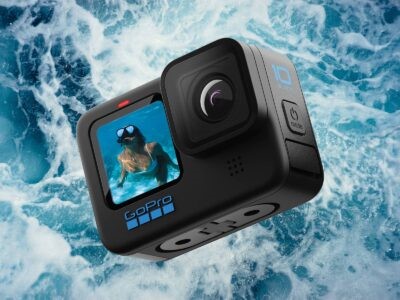
The Hero10 Black costs $449- on Amazon, which is relatively reasonable considering all it can accomplish (professional underwater set-ups that do similar things run into the thousands without breaking a sweat). That’s great and well worth it for GoPro dependability, excellent video stabilization, and 8x slo-mo footage. It’s worked wonderfully for me.
However, if you’re unsure about shelling out that much money for a Hero9, you can still receive many of the same capabilities and all the benefits of a GoPro for $349–399 with the GoPro Hero9 Black (see on Amazon).
The DJI Osmo Action (view on Amazon) is a capable runner-up that costs nearly half the price of the Hero9 Black. It has many of the same features as the Hero9 Black, including a waterproof build, slow-motion video, and image stabilization. It also features a front-facing screen for selfies (something the Hero8 Black lacks but the Hero9 does), which is helpful. Everything on the camera works ideally and is definitely worth the $199 price tag if the GoPro Hero9 Black (or Hero8) isn’t a good fit for you right now. A competent action camera is far superior to not having one.
Also, several important suggestions for snorkeling with action cameras…
First and foremost, if you use an action camera, you must have a floating hand grip. Videos taken with cameras attached directly to snorkel masks look terrible, and if you misplace your camera and it isn’t linked to anything like a floating handhold, it will fall to the bottom of the water and never be found again.
The CamKix Waterproof Telescopic Floating Hand Grip (see on Amazon) is my favorite since it can fully float with my GoPro connected, and the telescoping function depends on how I want to utilize it the camera. You may also store anything (money, wedding rings, etc.) within the hand grip that you would not want to leave on a boat or beach.
Following that, a large storage card is highly recommended (or even an extra one). Nothing is more frustrating than running out of space amid a diving day and having to limit your video (which has definitely happened to me). On a 64GB memory card, I can fit roughly a day’s worth of off-and-on snorkeling video at 2.7K (probably the lowest resolution I recommend recording in) but only just about. If I want to film in 4K (fantastic) or even 5K, I should be sensible and stick to 256GB.
SanDisk Extreme microSDXC UHS-I Card (view on Amazon)
With an action camera, the speed of the memory card is also critical. Varying memory cards record images and videos at different rates, and if the speed is too slow, the memory card will be unable to keep up with the video that the camera is feeding it, causing difficulties with your recording. The SanDisk Extreme microSDXC UHS-I Card is what I use (view on Amazon). It’s really inexpensive, and it’s never let me down.
(For more on using action cameras in the water, check out How to Use a GoPro for Snorkeling: 5 Easy Steps with Photos as well as The Newest GoPro for Snorkeling: 3 Keys for Buying or Upgrading to the Hero10 Black)
Snorkel Gear Bags

Once you’ve gathered all of your snorkeling equipment, you’ll need a place to store it. Many fantastic snorkeling places require trekking to get there and attempting to amble down a cliffside while carrying fins, mask, snorkel, and other gear doesn’t work out so well.
Everyday backpacks will hold your belongings in an emergency, but they’ll always become wet with seawater. That’s not the end of the world, but you should always wash your backpack, so the salt doesn’t eat away at the material over time, and getting damp on your back going out of an area isn’t ideal if you’ve just put on dry clothing.
To minimize these annoyances, I prefer to use a snorkel gear bag, such as the Stahlsac BVI (on Amazon) or the Stahlsac Panama (on Amazon). Both feature a similar design that waterproofs where the bag hits your body while allowing the goods to dry out thanks to strategically placed mesh.
Both bags also collapse flat, making them ideal for travel. The BVI is less expensive, although Panama has more excellent storage and fine structure. Panama is preferable if you can afford it, but if you want to save some money, the BVI will suffice.
Dry Bags
An excellent dry bag to keep your belongings dry inside may be helpful when snorkeling. You may be on a choppy-water boat with a cell phone, cash, or just a change of clothes that you don’t want to get wet. In this instance, a dry bag is preferable to a backpack or a snorkel gear bag.
You may have stuff you do not want to leave on a beach but do not have anybody to watch for you. In this situation, dry bags float when properly sealed, so you may drag them around while snorkeling if necessary. This floating feature would safeguard your belongings if they fell out of a boat or off a dock.
The Earth Pak Waterproof Dry Bag Roll-Top Dry Compression Sack appeals to me (view on Amazon). It’s dry, it floats, and it comes in a variety of sizes. The 10L capacity is usually plenty for beach knickknacks that you wish to take into the sea with you. If you’re searching for size to replace a backpack for outings, the 20L and 30L sizes are ideal.
Renting snorkel gear
It is possible to hire a lot of your essential snorkeling equipment, such as masks and snorkels, fins, and life jackets, which may be an excellent option if you are just getting started with snorkeling. However, there are a few things to keep an eye out for.
If you’d like more info on renting snorkel gear, read up on it over at How Much Does it Cost to Rent Snorkel Gear? Prices & Problems.
Also, if you’re doing a snorkel tour with a licensed operator, they’ll undoubtedly have some equipment available for you to use as part of the trip cost. However, this will be pretty basic equipment that will not provide you with the ideal experience. Renting equipment from a legitimate diving shop is nearly always a better alternative.
However, if you want to snorkel more than twice or three times in the next few years, I would strongly advise you to get your own mask and snorkel. Knowing what to anticipate from your gear, being able to snorkel whenever and wherever you choose, and selecting the best gear for your skill level will all be highly beneficial in terms of regularly having a good time on the water.
Conclusion
One of my favorite aspects of snorkeling is how simple and inexpensive it is to jump into the ocean and begin having beautiful experiences. With this advice, you can ensure that you have the best snorkeling gear for your expertise level and a few extras that will help your memories last a lifetime. Have fun snorkeling!
